

 | Computer Modeling in Engineering & Sciences |  |
DOI: 10.32604/cmes.2022.019442
ARTICLE
Assessment of the Solid Waste Disposal Method during COVID-19 Period Using the ELECTRE III Method in an Interval-Valued q-Rung Orthopair Fuzzy Approach
1Department of Mathematics, Bharathiar University, Coimbatore, 641 046, India
2Department of Industrial and Management Engineering, Inje University, Gimhae, 50834, Korea
*Corresponding Author: Daekook Kang. Email: dkkang@inje.ac.kr
Received: 24 December 2021; Accepted: 08 December 2021
Abstract: As the quantity of garbage created every day rises, solid waste management has become the world’s most important issue. As a result, improper solid waste disposal and major sanitary issues develop, which are only detected after they have become dangerous. Due to the system’s lockdown during the COVID-19 pandemic, this scenario became much more uncertain. We are at the stage to develop and execute effective waste management procedures, as well as long-term policies and forward-thinking programmes that can work even in the most adverse of scenarios. We incorporate major solid waste (organic and inorganic solid wastes) approaches that actually perform well in normal cases byreducing waste and environmental disasters; however, in such an uncertain scenario like the COVID-19 pandemic, the project automatically allows for a larger number of criteria, all of which are dealt with using fuzzy Multi-Criteria Group Decision Making (MCGDM) methods. The ELECTRE III (ELimination Et Choice Translating REality-III) approach, which is a novel decision-making strategy for determining the best way to dispose and reduce garbage by combining traditional ELECTRE III with an interval-valued q-rung orthopair fuzzy set (IVq-ROFS), is described in detail in this article. To confirm the efficacy of the recommended model, a numerical explanation is provided, as well as sensitivity and comparative analyses. Obviously, the findings encourage decision-makers in authorities to deliberate about the proposals before creating solid waste management policies.
Keywords: MCDM; organic waste; inorganic waste; ELECTRE III; interval-valued q-rung orthopair fuzzy number
Waste is in various forms like solid, fluid, or gas and each form of waste can be disposed of and purified by various methods. The management of waste deals with all forms of waste that pose the problems of waste disposal. The quantities of household and hospital waste are increasing day by day in the COVID-19 situation. Solid waste (SW) disposal in urban and rural areas appears to be one of the major issues currently faced by developed and developing countries during the lock-down period. Food waste, paper, plastic, metal, and glass, along with some harmful waste such as batteries, electric lights, parts of automobiles, and unused drugs, are the main wastes [1]. Solid waste may be categorized as organic waste and inorganic waste. Inappropriate handling of solid waste has various adverse effects such as degradation of natural resources, impact of soil pollution, groundwater pollution, air emissions and greenhouse gases (GHG), methane release, toxicity to humans and habitats [2]. The resulting GHG emissions, mainly
The key remedies are waste minimization and recycling, the management of hazardous air pollution in organic and inorganic waste incinerators, and alternative treatment and disposal practices. There is a range of available and evolving strategies for the disposal of solid wastes. Experts have emphasised the importance of reducing waste in order to save money and contribute to long-term waste management during the pandemic. Therefore, we need to concentrate on sustainable tactical approaches for solid waste collection and methods of waste disposal. Multi-criteria decision making (MCDM) is a crucial technique in decision-making assessment. An MCDM problem involves alternatives, criteria, criteria weights, and a decision matrix of alternatives. The elements of the decision matrix are the evaluator’s estimates for each criterion, which are used to compare the alternatives. As a result, it is critical to conduct extensive research on decision-making issues in order to fully express the judgement matrix and the weights of criteria. Hence, the disposal methods of solid waste problem considered as a MCDM problem when the experts have hesitation to in selecting the disposal techniques. We cannot always provide consistent assessment values of alternatives for the indeterminacy of experts and decision-making challenges to choose the best way in actual MCDM issues. To tackle this drawback, the fuzzy set theory described by Zadeh [3] used the membership function to explain the results of the calculation rather than the exact real-number. Another classification index was introduced by Atanassov [4], which designated the non-membership feature as a complement.
The IFSs and PFSs can precisely describe uncertain information, there are still difficulties that IFSs and PFSs can handle. When an expert gives a degree of membership and a non-membership value of 0.8 and 0.9, respectively, they do not satisfy the conditions of PFSs such as (0.8)2+(0.9)2 = 1.45 > 1. Yager introduced the q-rung orthopair fuzzy set (q-ROFS) concept [5], where the sum of the q-th power of the membership and q-th power non-membership is restricted to 1, that is

In this section, some studies related to SW, MSW, MCDM, ELECTRE III, and some relevant works from different parts of the world about SWM. Kharat et al. [9] proposed a fuzzy TOPSIS approach to develop an effective decision support framework not only for the design of new MSWM systems but also for the improvement of existing MSWM systems to achieve lower costs and greater eligibility in terms of environmental, social, cultural, and legal attractiveness requirements. Singh et al. [10] have used the fuzzy approach in managing the uncertainty problems in waste disposal. Badi et al. [11] have discussed to selecting the suitable site for the MSW dumping for the city of Misurata. Luo et al. [12] constructed a novel MCGDM methodology to manage and rank sustainable scenarios for MSWM. Rahimi et al. [13] have suggested the group fuzzy MULTIMOORA approach to achieve the optimum alternative and have used the group fuzzy BMW method to find the required weights for disposal of MSW for Mahallat in sustainable landfill site selection. Aghajani Mir et al. [14] proposed an enriched version of the TOPSIS method to identify the SWM treatment techniques and compared the results with the VIKOR method. Meegoda et al. [15] proposed the processes, parameters, and optimization of anaerobic digestion (AD). To reduce device costs and carbon dioxide
Here, we discuss the ELECTRE III method with various types of fuzzy sets. Chen et al. [23] proposed the MCGDM method based on ELECTRE III using probabilistic linguistic term set. Liao et al. [24] introduced the addition, subtraction and division operations for PLTSs and new beneficial algorithm for the PL-ELECTRE III method for solving a problem concerning the nurse?patient relationship. Chen et al. [25] developed a QFD and ELECTRE III-embedded hybrid MCGDM approach for sustainable building material selection under basic uncertain linguistic term set and the capability of BUI is extended in modeling the complex human reasoning. Mahmoudi et al. [26] investigated the use of a geographic information system (GIS) and multi-criteria evaluation (MCE) to locate a potential artificial recharge location for recovered water in Ariana, Tunisia. The ELECTRE III technique was utilized in this case to evaluate the potential places for aquifer recharge with treated water based on their features, which were weighted from highest to lowest: distance from the road, geometric structure of the area, cost of the location, and distance from marshlands. Based on the ELECTRE-III approach and a multiobjective evolutionary algorithm, a credit ranking model for parafinancial organisation is developed by Chavira et al. [27]. ELECTRE III is expanded with GIT2FSs to choose the finest MHE using a new ranking technique by Mohamadghasemi et al. [28]. Furthermore, GIT2FSs have access to various arithmetic operations and attributes and the suggested technique is used in a real life problem to highlight its possible applicability. Geetha et al. [29] presented the HPF-ELECTRE III method to determine the most adaptable recycling method for plastic materials. Ebadi Torkayesh et al. [30] analysed the complexities of waste-to-energy (WtE) planning as a solid waste treatment in Iran’s Azerbaijan area. The VIKOR method is used to choose the optimal WtE technology within that scenario. The ELECTRE III approach is then used to choose a suitable installation spot. To establish the weights of the criterion, the Fuzzy entropy approach was devised. Mohamadghasemi et al. [31] expanded the ELECTRE III approach to interval type-2 fuzzy sets (IT2FSs) utilizing curved (such as Gaussian) membership functions. According to Akram et al. [32], PFS-based decision making enhances the capability of intuitionistic fuzzy set-based decision making, which has the vitality of the ELECTRE III approach. In the trapezoidal interval type-2 fuzzy set environment, Geetha et al. [33] enhanced the optimal MCDM in ELECTRE III. Choosing the best location for a mustard mill may be considered as a MCDM problem. Bhol et al. [34] employed and detailed the ELECTRE III technique to evaluate several site options in increasing order of appropriateness. Ding et al. [35] worked on MSW in eight eastern coastal regions of China, emphasizing on background information, relevant legislation, MSW characteristics, and TTRU. Yang et al. [36] conducted a thorough analysis of PM sampling and measurement methodologies, formation mechanisms, distribution, inorganic content, and variables impacting PM emission during coal/biomass/MSW ignition. Lee et al. [37] recommended pyrolysis synergy as the key to the success of MSW slow pyrolysis practise, that treat waste with maximum resource retrieval and lowest carbon emission. Yaman et al. [38] investigated the possibilities for GHG reductions and energy recovery from MSW in Dammam, Saudi Arabia. Also, they was explored, as well as the quantity of landfill gas created, the possibility for energy conversion, and the environmental consequences in terms of Greenhouse gas emission. Gupta et al. [39] described municipal solid waste incineration bottom ash (MIBA) from three Delhi incineration plants. MIBA from three MSWI plants has been characterized in order to determine whether it should be disposed of or reused. Das et al. [40] proposed various MSW management methods, distinct problems, and reasonable solutions for people involved in waste management, as well as a potential management strategy during and after the COVID-19 pandemic. Liu et al. [41] utilized a coupled fuzzy MCDM technique to locate landfills in Lanzhou, a semi-arid valley basin city in China, to optimize the regional decision-making approach. Mishra et al. [42] discussed solid waste management models and disposals for various sceneries. Ali et al. [43] investigate the new CIVPFS principle and its algebraic operational laws. Certain Einstein operational laws based on the t-norm and t-conorm are also developed using the CIVPFSs. Certain properties of soft multi-set topology with applications in MCDM were established by Riaz et al. [44]. Sahu et al. [45] proposed picture fuzzy sets and rough set-based approaches to assist students in selecting an appropriate subject and, consequently, to provide a better service or contribution to the community.
Multi-criteria group decision making (MCGDM) is a valuable research topic with extensive theoretical and practical backgrounds. It refers to the problem of identifying or ranking alternatives based on the opinions provided by multiple experts relating multiple criteria. Many scholars have been derived to the MCGDM problem, and numerous solutions have been proposed. Numerous researchers have thoroughly researched MCGDM under these methods, such as the TOPSIS [14,46], ELECTRE and VIKOR [47], MULTIMOORA [13], and the PROMETHEE [48] method. In recent years, the q-rung orthopair fuzzy set (q-ROFS) has received a lot of recognition and has been widely used in the decision-making field. The q-ROFSs have a greater ability to explain complexity and confusion in contexts with extreme degrees of uncertainty.

Liu et al. [53] evaluated the q-rung orthopair fuzzy aggregation operators in MADM. One of the most well-known MCDM approaches addressing the problem of solid waste disposal is the ELECTRE III method. The proposed model expresses the concordance and discordance functions, as well as the optimum values of the ELECTRE III method’s preference, indifference, and veto threshold parameters, in terms of IVq-ROFNs, which can be considered significant contributions of the ELECTRE III method to the MCGDM methodology. The ELECTRE model has many types, including ELECTRE I, ELECTRE II, ELECTRE III, ELECTRE IV, ELECTRE V, and so on. The ELECTRE III approach has been used to find fuzzy binary relations to represent mutual preferences and Table 2 provides a review of literature on the different ELECTRE model in various forms of fuzzy sets. Here, the study developed the fuzzy ELECTRE III with IVq-ROFS which aims to improve the SWM in India during the COVID-19 pandemic period. The suggested treatment technique helps to reduce the amount of waste in this critical situation. We have compared our proposed method with some MCDM models, also conducted a sensitivity analysis.
• In the existing literature, numerous researchers have worked on the application of MSW management in various types of MCDM methods. The purpose of this research paper is to create a novel assessment model for the solid waste disposal problem.
• For solid waste disposal treatment in an IVq-ROF environment, there have been no studies that have used the fuzzy ELECTRE III method. As a consequence, it is necessary to fill the research gap for solid waste disposal treatments.
• We developed this based on the expense, society, ecosystems, and technological aspects, to dispose both organic and inorganic solid wastes effectively using IVq-ROFN-ELECTRE III. The ELECTRE III model effectively responds to the MSW technique applicability requirements which promote us to research and develop our proposed version.
• This type of MCDM study is to identify appropriate techniques for reducing waste and unsanitary ecological disasters. During the pandemic, this type of waste disposal system will improve waste management.
The contribution of this study are as follows:
• Performs waste disposable treatment in terms of low management and operational costs, low level pollutions, more social benefits and less ecological harms, we present the IVq-ROFS-ELECTRE III method, which chooses the weight detection technique and deploys alternatives at an ambiguous situation.
• Linguistic scales for interval-valued q-rung orthopair fuzzy sets are defined from a decider perspective, furthermore IV-q-ROFSs is more adaptable and has a wider optimal solution than other fuzzy sets.
• Comparative analysis to validate the suitability of ELECTRE III method for our proposed organic and inorganic waste disposable problem with existing techniques such as TOPSIS, MULTIMOORA, and MABAC. Meanwhile, the sustainability also analysed and presented in the form of sensitivity analysis.
The paper further proceeds in Section 3 that discusses preliminaries, Section 4 presents the mathematical methods, Section 5 provides the numerical example is illustrated to show the efficiency of the proposed method and Section 6 presents comparison and sensitivity analysis. Finally, conclusion and future work are given in Section 7.
Definition 3.1 [5] Assume that U be a non-empty fix set, then a q-ROFS F on U can be described as follows:
where
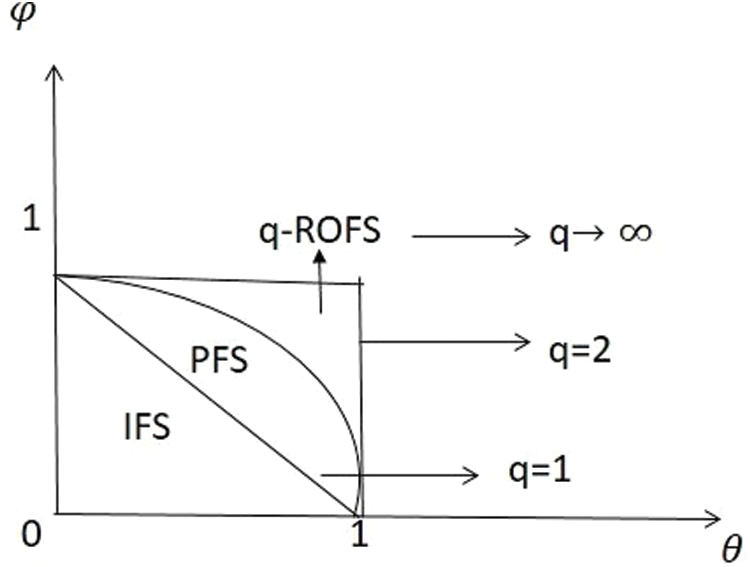
Figure 1: The relationship between IFS, PFS, and q-ROFS
Definition 3.2 [6] Assume U be a non-empty fixed set, an interval-valued q-rung orthopair fuzzy set (IVq-ROFS) F on U can be described as follows:
where
Definition 3.3 [6] Let
Definition 3.4 [6] Let
in which
Definition 3.5 [54] Let
in which
We can find the particular form of the aggregation result, which is given in below theorem.
Theorem 3.1 [6] Let
Theorem 3.2 [6,54] Let
Theorems 3.1 and 3.2 can be proved by the mathematical induction, which is not repeated here.
Definition 3.6 [55] Let
4.1 The Conventional ELECTRE III Model
Let
The ELECTRE III model’s assessment process include the formation of a threshold function, the disclosure of concordance and discordance indices, the determination of the credibility degree, and the ranking of the alternatives. The ELECTRE III procedure and computations are shown below.
Step 1: The concordance index C(o1, o2) is calculated for every pair of alternatives:
where CCMi(o1, o2) is the outranking degree of the alternative o1 and o2 under the criteria i, and
Thus,
Step 2: The discordance index DCM(o1, o2) for each criterion is described below:
Thus,
Step 3: Finally, the degree of outranking is defined by S(o1, o2):
where J(o1, o2) is the set of criteria for which DCM(o1, o2) > CCM(o1, o2).
Step 4: To calculate the complete ranking of the alternatives and the concordance credibility degree, the discordance credibility degree and the net credibility degree are obtained as:
• The concordance credibility value is described by
The concordance credibility is a proportion of Oi’s outranking character.
• The discordance credibility value is described by
s The discordance credibility is a portrays of Oi’s outranking character.
• The net credibility value is described by
The net credibility degree describes the value system, with a higher value reflecting the attractiveness of the alternative oi. Then, using the net credibility degree, all of the alternatives can be completely ranked.
Here, we expand the ELECTRE III method with IVq-ROFSs. Consider a u alternatives
Step 1: Obtain the significance of each expert It is necessary to assess the significance of each expert in the final judgement. Let
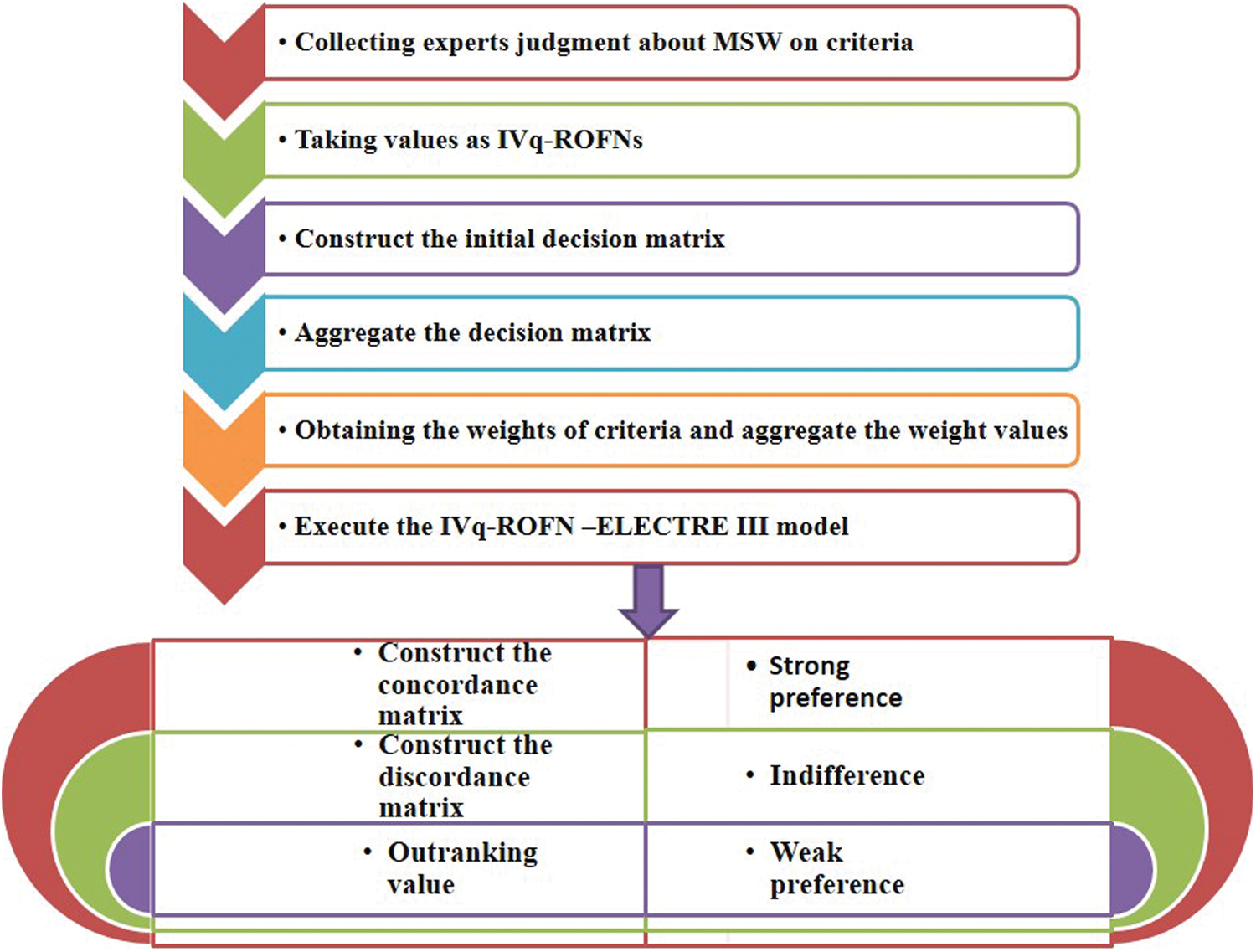
Figure 2: Pictorial representation of the proposed method
Step 2: Construct the matrix and aggregate the experts matrix
Here, experts express their point of view, and assess the alternatives using the linguistic scale seen in Table 3 which is expressed by the IVq-ROFNs. Let

The aggregate the decision maker’s matrices as follows:
The aggregated decision matrix R is


Step 3: Calculate the criterion weights Let
Step 4: Construct the concordance matrix For concordance matrix CCM(o1, o2), we should first find the thresholds, which are F, T, M represents the strong preference, weak preference, and indifference respectively and the CCM is calculated by Eq. (13).
where
where S(o1), S(o2), S(Fi) and S(Ti) are calculated by Eq. (3).
Step 5: Construct the discordance matrix
Obtain the discordance matrix DCM(o1, o2). The DCM is described in given Eq. (14).
where,
Step 6: Calculate the outranking degree S(o1, o2) is in (15)
Step 7: Finally, ranting the alternatives based on concordance credibility, the discordance credibility, and the net credibility values.
• The concordance credibility value is described by
The concordance credibility is a proportion of Oi’s outranking character.
• The discordance credibility value is described by
The discordance credibility is a portrays of Oi’s outranking character.
• The net credibility value is described by
The net credibility value reflects the worth capability, with a higher worth indicating a huge engaging quality of oi. Both oi’s can be fully placed based on net credibility.
The world is facing solid waste management as an important issue in the current situation, with household and health-care solid waste amounts increasing during this lock-down period. The spread of COVID-19 altered people’s lifestyles, resulting in an increase in waste and difficulties in disposing of solid waste. We make it necessary to improve waste disposal in a responsible manner. As a result, several attempts have been made to find waste disposal solutions that reduce waste while also reducing the risk of COVID-19 transmission through solid waste. In India, SW (organic & inorganic waste) disposal is at a crucial level of development. Hence the facility to dispose the wastes should be improved. It is estimated that over 90 percentage of the waste in India is dumped in an unsatisfactory manner. Properly planned management of waste improves public health and protects critical natural resources such as surface water, soil fertility, and air quality. Interactions with SW processes at open dump areas are at serious risk in developing countries. Waste administrators are specifically affected by the handling of these solid wastes and by workplace risks or illnesses and infections transmitted to their employees. There are a variety of critical public health implications of SW. It has adverse consequences directly or implicitly on various groups of individuals, such as waste collectors, municipal employees, and waste disposal workers. Skin inflammation, typhoid fever, cholera, asthma, cancer, vomiting, food poisoning, etc., are diseases related to improper disposal of waste.
The most popular waste management strategies, such as dumping at open sites and traditional incineration, are practiced in many countries. Such approaches are rather unhygienic and pose a serious challenge to public health and the ecosystems. The design and operation of sustainable and robust waste management schemes includes the collection, transport and recycling of solid waste. SW contains organic and inorganic materials, which are shown in Fig. 3. Organic waste: Biologically generated waste (which was once alive or was part of an organism). Inorganic waste: Non-biological waste is a form of waste that does not have a biological basis (industrial origin or any non-natural process). Organic waste application has long been recognized as valuable to soil fertility, erection, water preservation, and buffering skill. The majority of solid waste is organic, with just a small volume of inorganic waste and no hazardous waste (SBMG, 2015). Here, we consider the four alternatives to dispose organic and inorganic waste and explained as follows [1,2].
Recycling& Sanitary Landfills (RC & SL): Recycling is a method by which products are stored, handled, and re-manufactured that is otherwise intended for disposal. Recycling diverts a large fraction of metropolitan, institutional and industry waste from recycling, thus saving precious environmental resources, reducing the effect on the environment and the cost of waste control on public authorities. Sanitary landfills are structures planned and built for the ultimate disposal of solid waste on land to reduce environmental impacts. A modern landscape that meets these requirements is a complex facility with various equipment to reduce environmental impacts. Non-useable, non-recyclable, non-biodegradable, non-combustible and non-reactive inert waste to go to sanitary landfills and pre-processing rejects and contaminants from waste processing facilities are permitted in sanitary landfills. The best landfill site is the one dispose method which minimizes the negative effects on the society and ecosystem, as well as has the greatest economic and engineering performance.
Anaerobic Digestion: Anaerobic digestion (AD) is a mechanism in which, in the absence of oxygen, organic matter is converted into biogas and digested. The longevity of MSW’s AD is based on multiple factors. In order to be sustainable, the sum of benefits needs to outweigh the effects of the AD operation (pre-treatment, digestion process and post-treatment) as well as logistics. As a result of the evolving issue of waste management and energy protection, AD has gained expanded research attention and implementation. It provides numerous environmental advantages, including green energy generation, agricultural waste collection, and environmental conservation and GHG emission reductions. The solids developed after the AD phase can be used as soil modifications that are good for the environment. In addition to technological and economic treatment evaluations, adding environmental impact assessments would enable biogas processing to be ecosystem friendly.

Figure 3: Solid waste disposal problem
Incineration: An incineration is a form of waste disposal that involves the burning of waste in the presence of oxygen at extremely high temperatures, resulting in the creation of ash, flue gas, and heat. Besides the separated fraction of high calorific waste, it is feasible for unprocessed or minimally processed refuse. Incineration is an alternative to be explored only when adequate resource recycling and reuse systems have been introduced or when other viable production solutions are not possible and the availability of land is a concern.
Aerobic Composting: Biologically, composting is a regulated aerobic process of “digesting” the SW can be recycled for plant nutrients, stabilization, soil in the remediation process, or soil alteration for low soil regeneration. Depending on the feasibility of implementation, compost production can be carried out at a decentralized level or a centralized level. Both processes require substantial pre-processing, and it is possible to compost only segregated organic matter. Home composting, bin composting, box composting, vermicomposting, in-vessel composting are the decentralized level, and windrow composting, aerated static pile, in-vessel composting are centralized level.
The proposed methodology is used in this section to assess the disposal method for organic and inorganic waste. The best method of disposal that has the least ecological impact is obtained and is useful for all societal requirements, to this end we have chosen eight criteria to evaluate the four alternatives, which are given as follows:
• Cost (P1): There are various cost problems based on the type of disposal treatment and technology.
• Healthy and safety (P2): The safety of people’s health is the most important criterion in waste management. Solid waste disposal treatments ensure that workers personal safety are protected by proper management, treatment, processing, and disposal procedures.
• Air pollution (P3): Some waste disposal pollutes the environment because chemicals are used to dispose of some waste.
• Noise pollution (P4): The unpleasant, irritating sound made when waste is disposed of, which annoys both workers and society. Diseases are also caused by it.
• Soil and water pollution (P5): When waste disposal treatment is implemented, it reduces the soil and water, have to improve the quality of the soil and water.
• Workers (P6): Employees who are responsible for waste disposal and the operation of the solid waste management infrastructure framework.
• Technical efficiency and feasibility (P7): Sufficient technologies need to operates the disposal methods for wastes.
• Land requirement and equipment facilities (P8): Land and equipment are required to properly dispose of waste.
Here, we consider three decision-makers to evaluate the alternatives. Then, the alternatives are Recycling & Sanitary Landfills (O1), Anaerobic Digestion (O2), Incineration (O3), and Aerobic Composting (O4). The selected alternatives and criterion are shown in Fig. 4.
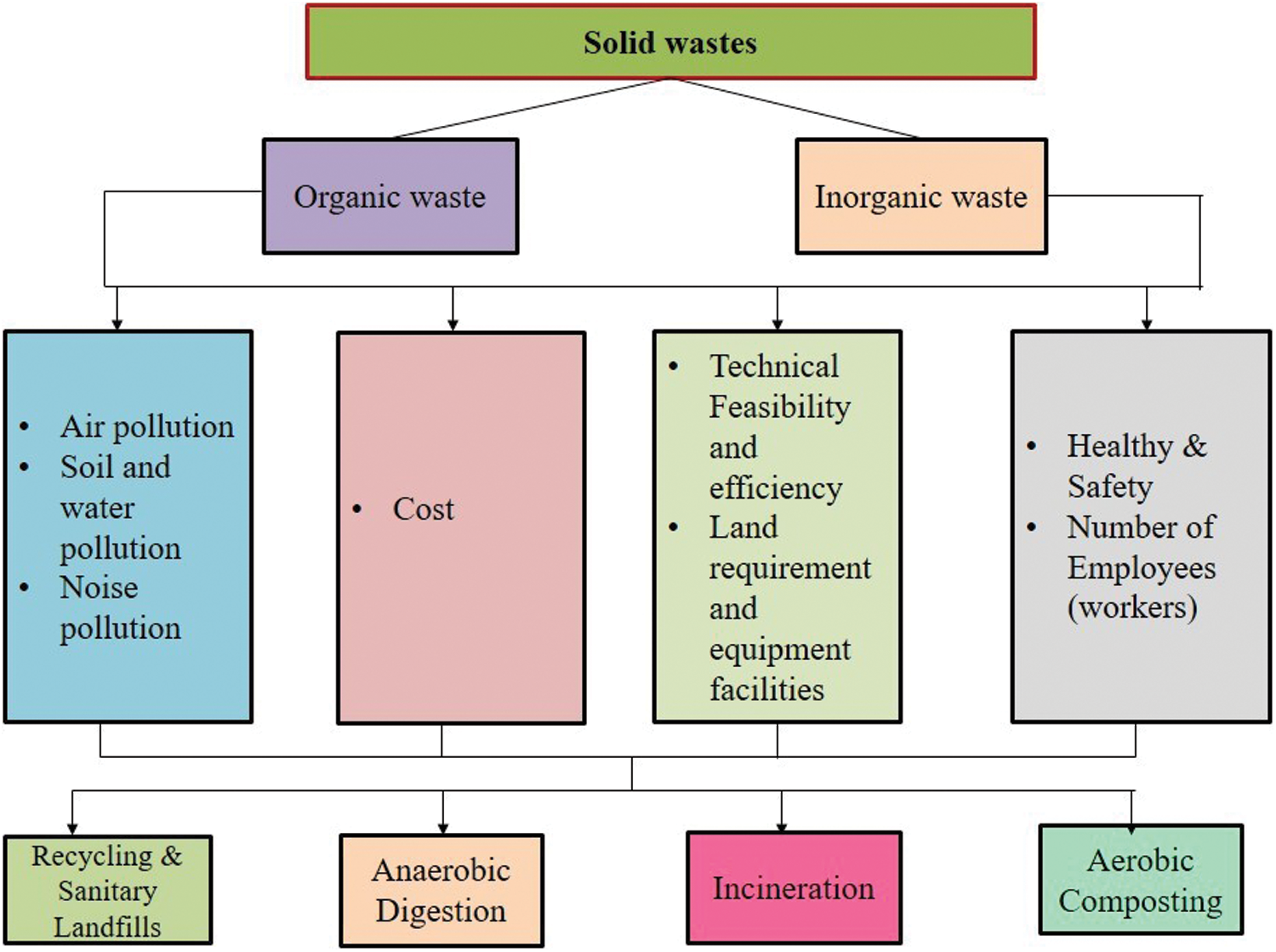
Figure 4: Organic & inorganic waste disposal method
Materials that are derived from living beings produce organic waste. The various forms of organic waste includes industries, municipal, waste water and food waste. Agricultural waste, food-soiled paper, food waste, non-hazardous wood waste, and landscaping are examples of organic waste. Food waste is mostly disposed in landfills or incinerators alongside other waste, but because it is biodegradable, some organic waste is ideal for composting and soil application. Organic content that can be broken into carbon dioxide, nitrogen, or basic organic compounds is biodegradable waste. Here, the decision makers evaluate the organic waste under the criteria which is represented as an IVq-ROFSs. The linguistic scale can be used to assessment alternatives that can assist experts to clearly express their evidence and viewpoints, which is shown in Tables 3 and 4. We are now analyzing organic waste using the proposed method.

The following alternatives are considered for evaluation: O1-Recycling & Sanitary Landfills (RC & SL), O2-Anaerobic Digestion, O3-Incineration and O4-Aerobic Composting based on the eight criteria by three experts



Step 1: Obtain the significance of each expert. The importance of the weight vector for each expert is
Step 2: Now, the construct the initial matrix using the linguistic scale, decision makers evaluate the organic waste disposal under the selected criterion and the aggregation of the expert’s matrix is shown in Table 8.

Step 3: The significance of each criteria by experts judgment is shown in Table 9. Then, using the IVq-ROFWA aggregation operator we can find the weight of the criteria’s.

Now, the weight of the criterion are calculated using Eq. (11),
Step 4: For concordance matrix, the thresholds for alternatives are construct and which is shown in Table 10.

To determine the CCM, it is need to find the S(Oj) and S(wj), as given in Table 11.

Now, the CCM is determined base on the comparison of the alternatives using Eq. (13), the results shown in Table 12.

Step 5: The discordance matrix is obtained using (14) and the results are given in Table 13.

Step 6: Then, the comparison between the CCM and DCM are calculated using Eq. (15) and the credibility matrix is given in Table 14.

Step 7: Finally, according to the Eqs. (16)–(18), the ranking results are obtained and shown in Table 15 and Fig. 5.

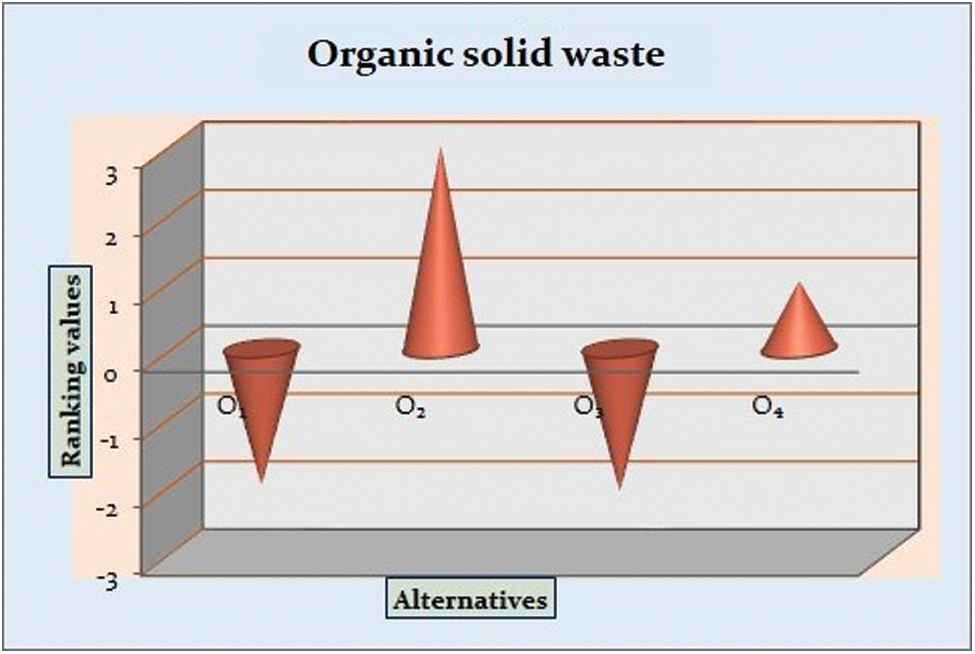
Figure 5: Ranking results for organic solid waste
Table 15 shows the net credibility value reflects the worth of capacity and huge engaging quality of the alternatives. According to CRINIRDPR (2016), separated organic waste can be composted using appropriate composting and anaerobic digestion technologies. Owing to the availability of high organic and moisture content, anaerobic digestion is one of the most technically feasible bio-methanation processes for organic solid wastes. Here, the alternative O2-Anaerobic Digestion is the best disposal method for organic waste by proposed method.
Non-biological waste is a form of waste that does not have a biological basis (industrial origin or any non-natural process). Inorganic wastes are not affected in the slightest by microorganisms that are in the procedure of putrefaction. Therefore, it take a long period to degradable. Meanwhile, organic wastes are biodegradable. They are capable of being decomposed by bacteria or other organisms so they can decompose. Some examples of inorganic waste are aluminum cans, spoons, plastics, and glass. And a few instances of organic waste are paper, cardboard, and food remains. Here, the decision makers evaluate the inorganic waste under the criteria which is represented as an IVq-ROFSs. The linguistic scale can be used to assessment alternatives that can assist experts to clearly express their evidence and viewpoints, which is shown in Tables 3 and 4. We are now analyzing disposal of inorganic waste using the proposed method.
The following alternatives are considered for evaluation: O1-Recycling & Sanitary Landfills, O2-Anaerobic Digestion, O3-Incineration and O4-Aerobic Composting based on the eight criteria by three experts



Step 1: Determine the significance of each expert. The importance of the weight vector for each expert is
Step 2: Now, the construct the initial matrix using the linguistic scale, decision makers evaluate the inorganic waste disposal under the selected criterion and the aggregation of the expert’s matrix is shown in Table 19.

Step 3: The significance of each criteria by experts judgment is shown in Table 9. Then, using the IVq-ROFWA aggregation operator we can calculate the criteria’s weights using Eq. (11).
Step 4: For concordance matrix, the thresholds for alternatives are construct and which is shown in Table 10. To determine the CCM, it is need to find the S(Oj) and S(wj), as given in Table 20.

Now, the CCM is determined base on the comparison of the alternatives using Eq. (13), the results shown in Table 21.

Step 5: The DCM is obtained using (14) and the results are given in Table 22.
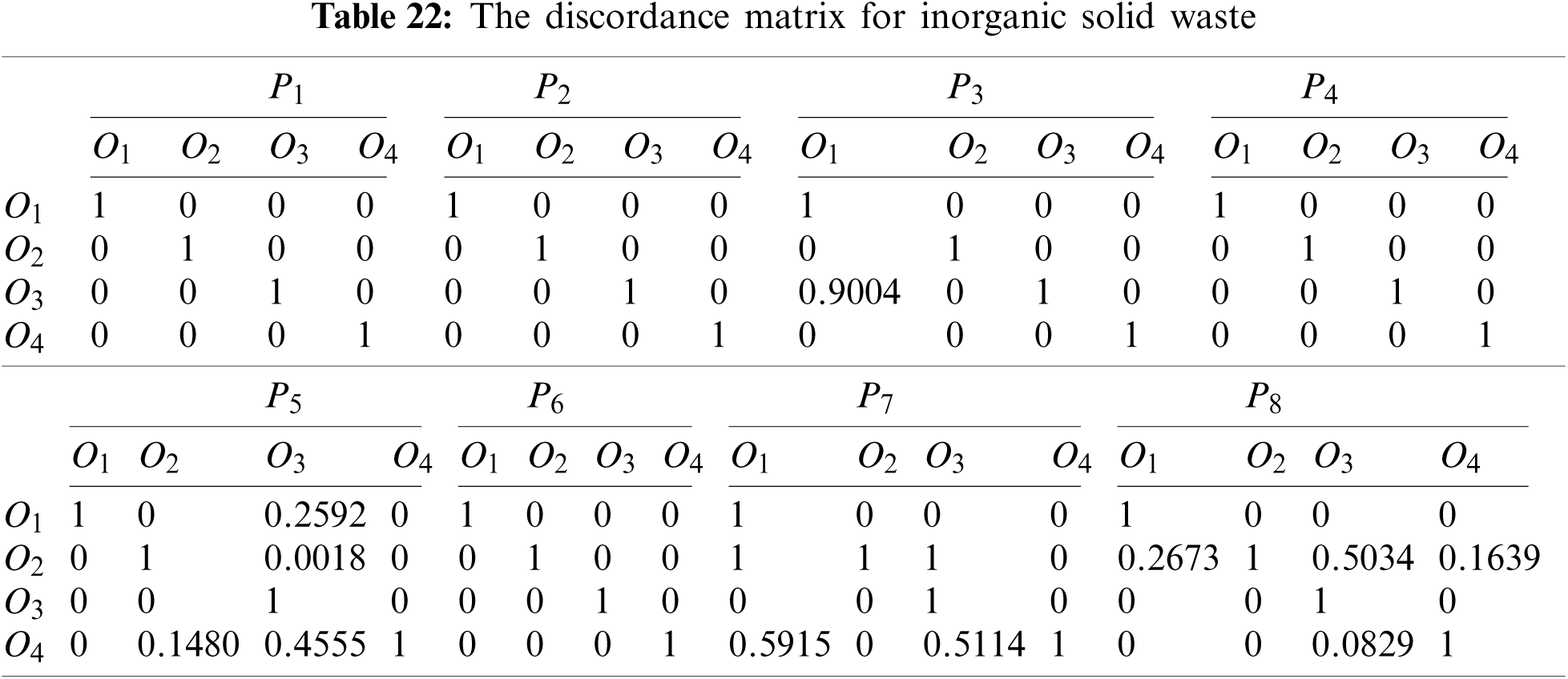
Step 6: Then, the comparison between the CCM and DCM are calculated using Eq. (15) and the credibility matrix is given in Table 23.

Step 7: Finally, according to the Eqs. (16)–(18), the ranking results are obtained and shown in Table 24 and Fig. 6.
Table 24 shows the net credibility value reflects the worth of capacity and huge engaging quality of the alternatives. Recycling saves a substantial amount of industrial, institutional, and bulk inorganic waste from being discarded or disposed of in landfills. This saves scarce money while still reducing environmental impacts. A new landfill that is in compliance with inorganic waste is a sophisticated facility with a variety of facilities designed to reduce environmental impacts. According to CRINIRDPR (2016), inorganic recyclable waste can be sold to government-approved recyclers, and non-recyclable waste can be sent to a local municipality and municipal council for proper landfill. Before planning any waste collection or disposal plants, recycling and sanitary landfill schemes should be implemented. Here, the alternative O1-Recycling & Sanitary Landfills (RC & SL) is the best disposal method for inorganic waste by proposed method.

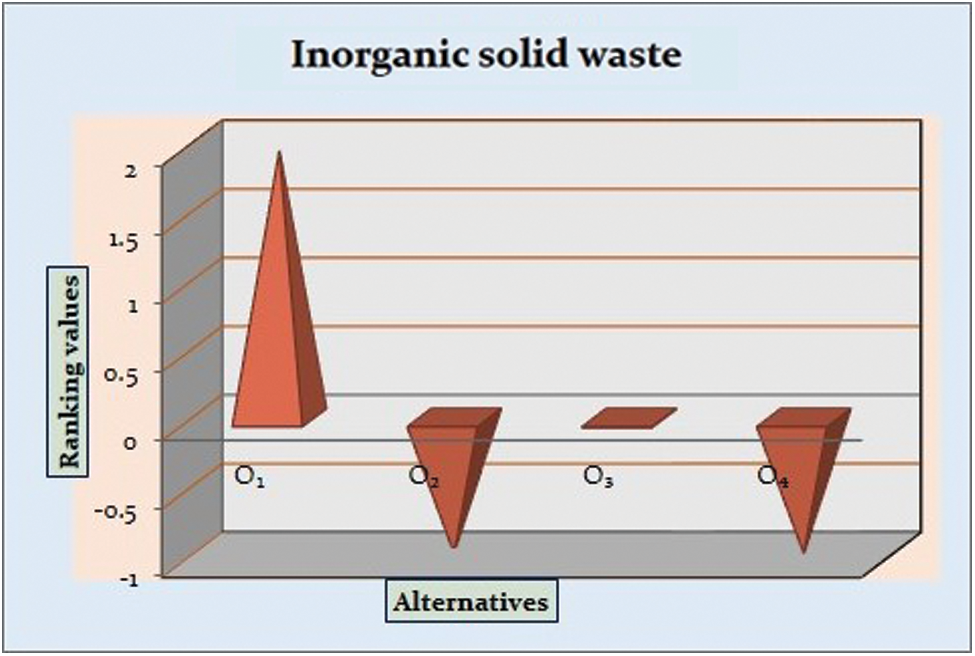
Figure 6: Ranking results for inorganic waste
6 Result Validation and Discussion
Sensitivity analysis: The sensitivity analysis of the proposed solid waste disposal method is shown in this section based on the three cases of parameters q = (3, 7, 10) and the expert weight vector (0.30, 0.45, 0.25). The sensitivity analysis of this model is compared to the results of three cases, which are shown in Table 25 and the graphical representation in Fig. 7. These cases are found here by varying the value of parameter q. In this paper, the disposal method is chosen based on eight criteria, which approximate the data ranking in practice. The IV-q-ROFS-ELECTRE III method is used to find alternative ranks. Different scores and ranking results can be obtained by assigning different values to the parameter q.
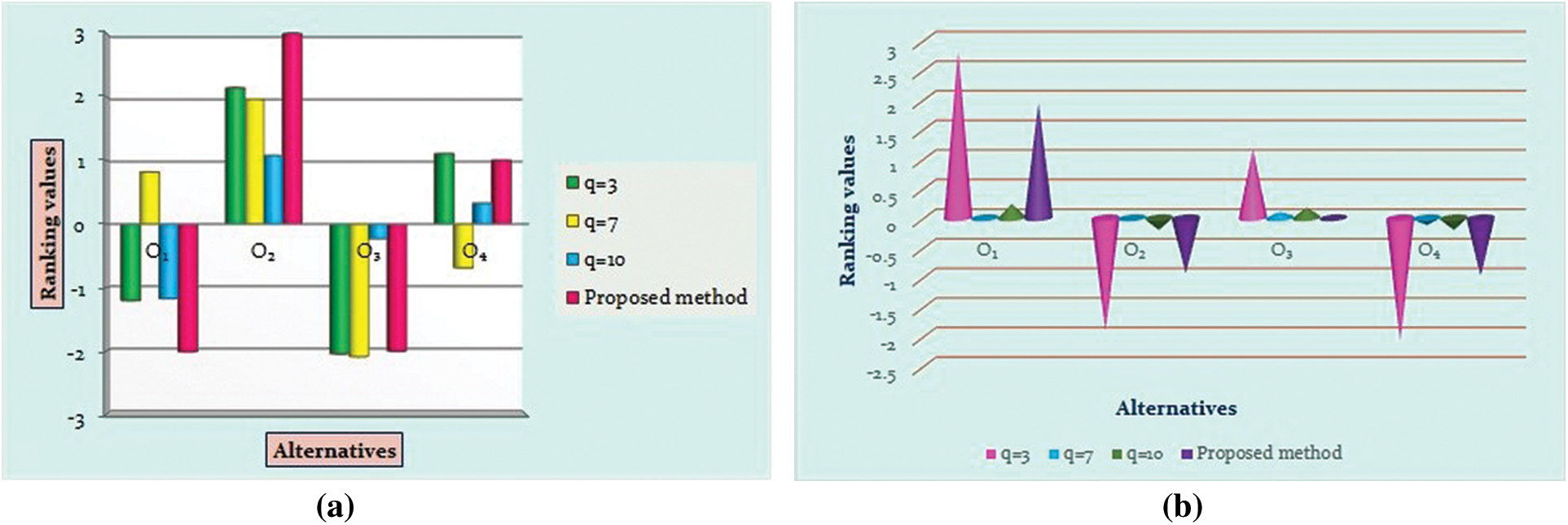
Figure 7: (a) Sensitivity results for organic waste, (b) Sensitivity results for inorganic waste
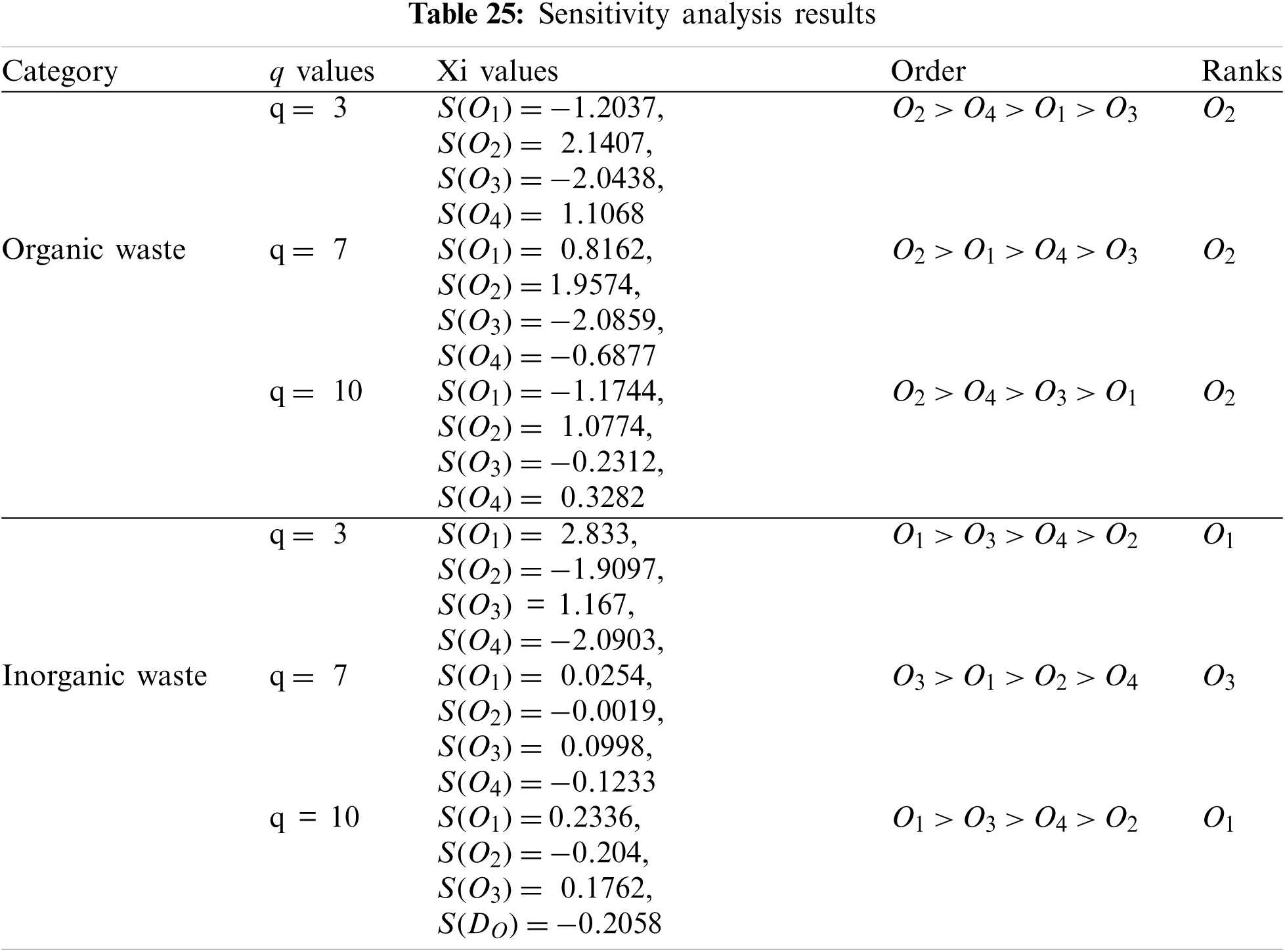
Comparative analysis: The ELECTRE III is compatible with our application when compared to the TOPSIS, MULTIMOORA and MABAC which is depicted in the Figs. 8 and 9. When compared to other methods, the comparison analysis in this paper produces more reasonable and robust results. In summary, as compared to TOPSIS, MULTIMOORA and MABAC methods, ELECTRE III method enforces the inter-comparison of alternatives. Further, the decision results extracted from ELECTRE III method come up with additional information in the form of credibility index of outranking relations among the alternatives which is more useful in the cases when the alternatives in problem are large in number. Moreover, ELECTRE family of methods are more preferable for problems with larger number of alternatives and fewer criteria. The process of exploitation of outranking relations adopted in present extensions of ELECTRE III method is complex and requires more calculations and construction of graphs, whereas our method has simplified it by computing the concordance credibility, discordance credibility, and net credibility degree of each alternative to extract partial pre-ordering of alternatives from outranking relations. The ranking lists for the three methods differ in Table 26 and also shows the ranking order results and the graphical representations are given in Figs. 8 and 9. Here, we only considered eight criteria for evaluating alternatives in this paper, but future studies may use the proposed approach to consider additional criteria such as operating expense, risk factors, and benefits to society.

Figure 8: Comparison results for organic waste. (a) TOPSIS ranking values (b) MULTIMOORA ranking values (c) MABAC ranking values (d) IVq-ROFS-ELECTRE III ranking values
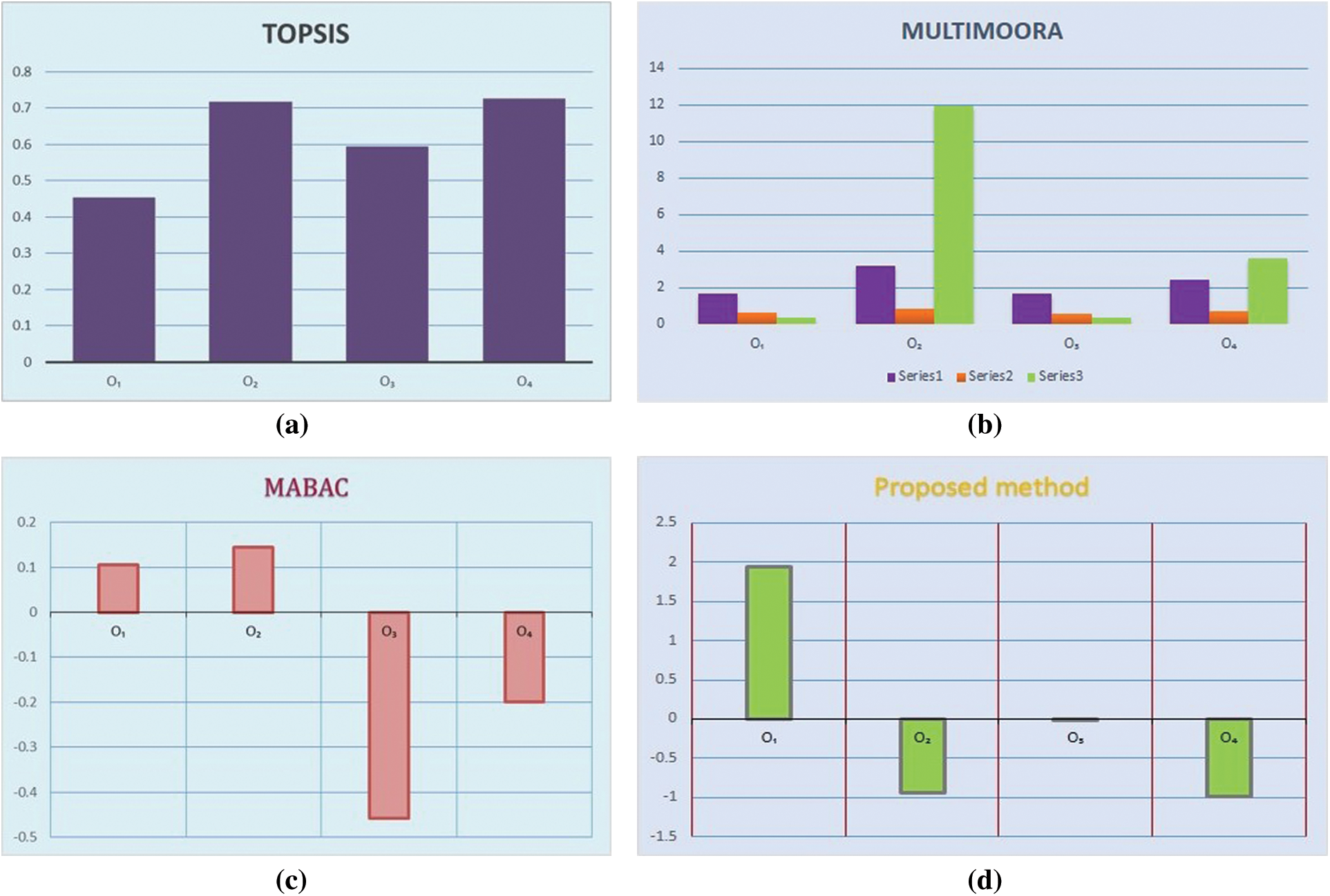
Figure 9: Comparison results for inorganic waste. (a) TOPSIS ranking values (b) MULTIMOORA ranking values (c) MABAC ranking values (d) IVq-ROFS-ELECTRE III ranking values
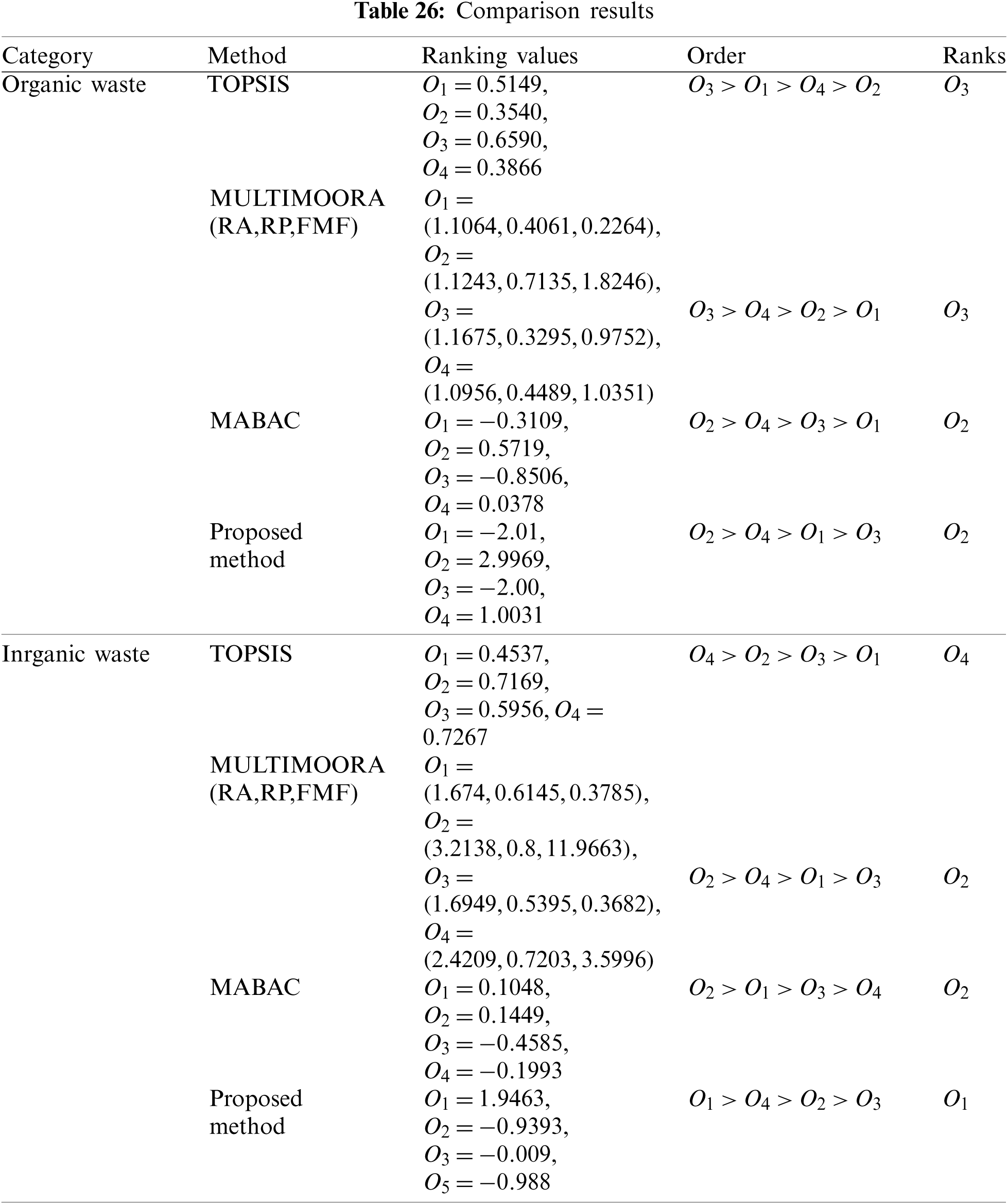
An ELECTRE III application is divided into two parts: First, the structure of one or more outranking relations with the aim of comparing each pair of acts comprehensively. Second, a protocol for manipulation that expands on the guidelines received in the first phase. The essence of the recommendation is determined by the issue at hand: selecting, rating, or sorting. The ELECTRE III methods are typically used to exclude undesirable solutions to a problem.
As explained previously, the proposed IVq-ROFS-ELECTRE III process has the following advantages:
• The ELECTRE III approach has several advantages in decision-making scenarios. In contrast to ELECTRE II, ELECTRE III is an approach that use a systematic procedure to determine the link between options. The key advantage of this strategy is that the decision maker is directly involved in the decision-making process. ELECTRE III is an interaction approach.
• Another feature of ELECTRE III is the ability to define indifference and preference thresholds. When the data are equivalent and similarly weighted, the options are considered for equally.
• Because of the lesser precision, indifference and preference thresholds are specified to demonstrate their choice or indifference in comparison to other options. This indicates that when the performance of two alternatives is less than the defined quantity in a certain criteria, the alternatives are regarded indifferent in that criterion.
• Finally, the ELECTRE III allows a decision maker to examine both qualitative and quantitative factors at various levels of uncertainty. The establishment of thresholds is a challenge in the implementation of this strategy.
• The advantage of using the ELECTRE III previously is that we can add another MCGDM with a limited set of alternatives, saving us a lot of time. In this processes, criteria have two distinctive sets of structures: significance coefficients and veto thresholds.
7 Conclusion and Future Research Directions
Some of the most notable challenges in waste management include a lack of awareness of health concerns, poor waste control, environmental deterioration, and a lack of financial and human capital. By concentrating on the sorts of garbage that can help us enhance our cleanliness during the COVID-19 epidemic, we have offered organic and inorganic solid waste disposal solutions. In developing nations, trash is often disposed of by burning, landfilling, or dumping, however these procedures are not acceptable for all forms of waste created by SW systems. The new SWM collecting efforts are also planned to include a number of enhancements and innovations due to uncertainty. As a result, when compared to existing decision-making methods, the suggested group decision-aiding two-phase IVq-ROF-ELECTRE III model is more realistically relevant in real-world circumstances. Because an IVq-ROFS may communicate expert preferences in a variety of ways, it has been frequently employed to solve MCDM issues. First, we created a linguistic scale of IVq-ROFNs that included membership and non-membership values in this study. This paradigm allowed for a more comprehensive interpretation of human preference and non-preference data. The suggested method takes use of the ability of IVq-ROF sets to anticipate information on expert-generated uncertainty. The ELECTRE III is chosen as an appropriate approach in this study, and one of its differentiating features is its capacity to handle data with a high degree of uncertainty. Another benefit of the ELECTRE III is that it is completely compatible with environmental cleanup. Furthermore, the ELECTRE III uses pairwise comparison to compare the options. The proportional relevance of each criterion in respect to the decision maker’s preference structure is weighted. As a consequence, this version of ELECTRE III outperforms other MCDM approaches. As a result, we recommend that the authorities use our proposed fuzzy ELECTRE III approach to review the choice and examine the alternatives before implementing sustainable policies.
7.2 Limitations and Future Research Directions
The ELECTRE III strategy met the solid waste disposal procedures applicability requirements, according to an observational assessment. Using the ELECTRE III approach (shown in Fig. 2), we built and evaluated our suggested version. These findings reveal that when using the ELECTRE III technique to choose a disposal treatment option, the user cannot acquire erroneous information. Other weight-finding methods, such as subjective or objective weight detection methods, are challenging to combine with the ELECTRE III approach. Because the membership and non-membership values in the investigated solid waste disposal problem are stated as interval numbers, the operators utilised for aggregation in MCGDM approaches struggled to handle them, applying the IVq-ROFS to the suggested solution took longer. We will use the suggested IVq-ROFN-ELECTRE III approach to solve other challenges in the future, such as bio-medical waste disposal and site selection. Furthermore, applying the suggested approach in either a hesitant q-ROFS environment is an intriguing avenue to investigate, since Hq-ROFSs may express fuzzy information more effectively than q-ROFS.
Funding Statement: This work was supported by the National Research Foundation (NRF) of Korea Grant funded by the Korean Government (MSIT) (NRF-2020S1A5A8044635).
Conflicts of Interest: The authors declare that they have no conflicts of interest to report regarding the present study.
1. Government of India swachh bharat mission (2016). Municipal solid waste management manual-Part I. Central Public Health and Environmental Engineering Organisation (CPHEEO). https://moud.gov.in. [Google Scholar]
2. Government of India swachh bharat mission (2016). Municipal solid waste management manual-Part II. Central Public Health and Environmental Engineering Organisation (CPHEEO). https://moud.gov.in. [Google Scholar]
3. Zadeh, L. A. (1965). Fuzzy sets. Information and Control, 8(3), 338–353. DOI 10.1016/S0019-9958(65)90241-X. [Google Scholar] [CrossRef]
4. Atanassov, K. T. (1986). Intuitionistic fuzzy sets. Fuzzy Sets and Systems, 20(1), 87–96. DOI 10.1016/S0165-0114(86)80034-3. [Google Scholar] [CrossRef]
5. Yager, R. R. (2017). Generalized orthopair fuzzy sets. IEEE Transactions on Fuzzy Systems, 25(5), 1222–1230. DOI 10.1109/TFUZZ.2016.2604005. [Google Scholar] [CrossRef]
6. Ju, Y., Luo, C., Ma, J., Gao, H., Ernesto, D. R. et al. (2019). Some interval-valued q-rung orthopair weighted averaging operators and their applications to multiple-attribute decision making. International Journal of Intelligent Systems, 34(10), 2584–2606. DOI 10.1002/int.22163. [Google Scholar] [CrossRef]
7. Joshi, B. P., Singh, A., Bhatt, P. K., Vaisla, K. S. (2018). Interval valued q-rung orthopair fuzzy sets and their properties. Journal of Intelligent and Fuzzy Systems, 35(5), 5225–5230. DOI 10.3233/JIFS-169806. [Google Scholar] [CrossRef]
8. Figueira, J. R., Mousseau, V., Roy, B. (2016). ELECTRE methods. In: Multiple criteria decision analysis, pp. 155–185. [Google Scholar]
9. Kharat, M. G., Murthy, S., Kamble, S. J., Raut, R. D., Sachin, S. et al. (2019). Fuzzy multi-criteria decision analysis for environmentally conscious solid waste treatment and disposal technology selection. Technology in Society, 57, 20–29. DOI 10.1016/j.techsoc.2018.12.005. [Google Scholar] [CrossRef]
10. Singh, A. (2019). Managing the uncertainty problems of municipal solid waste disposal. Journal of Environmental Management, 240, 259–265. DOI 10.1016/j.jenvman.2019.03.025. [Google Scholar] [CrossRef]
11. Badi, I., Kridish, M. (2020). Landfill site selection using a novel FUCOM-CODAS model: A case study in Libya. Scientific African, 9, e00537. DOI 10.1016/j.sciaf.2020.e00537. [Google Scholar] [CrossRef]
12. Luo, C., Ju, Y., Giannakis, M., Dong, P., Wang, A. (2021). A novel methodology to select sustainable municipal solid waste management scenarios from three-way decisions perspective. Journal of Cleaner Production, 280, 124312. DOI 10.1016/j.jclepro.2020.124312. [Google Scholar] [CrossRef]
13. Rahimi, S., Hafezalkotob, A., Monavari, S. M., Hafezalkotob, A., Rahimi, R. (2020). Sustainable landfill site selection for municipal solid waste based on a hybrid decision-making approach: Fuzzy group BWM-MULTIMOORA-GIS. Journal of Cleaner Production, 248, 119186. DOI 10.1016/j.jclepro.2019.119186. [Google Scholar] [CrossRef]
14. Aghajani Mir, M., Taherei Ghazvinei, P., Sulaiman, N. M. N., Basri, N. E. A., Saheri, S. et al. (2016). Application of TOPSIS and VIKOR improved versions in a multi criteria decision analysis to develop an optimized municipal solid waste management model. Journal of Environmental Management, 166, 109–115. DOI 10.1016/j.jenvman.2015.09.028. [Google Scholar] [CrossRef]
15. Meegoda, J. N., Li, B., Patel, K., Wang, L. B. (2018). A review of the processes, parameters, and optimization of anaerobic digestion. International Journal of Environmental Research and Public Health, 15(10), 2224. DOI 10.3390/ijerph15102224. [Google Scholar] [CrossRef]
16. Mohsenizadeha, M., Turala, M. K., Kentel, E. (2020). Municipal solid waste management with cost minimization and emission control objectives: A case study of Ankara. Sustainable Cities and Society, 52, 101807. DOI 10.1016/j.scs.2019.101807. [Google Scholar] [CrossRef]
17. Fana, Y. V., Klemesa, J. J., Leeb, C. T., Perry, S. (2018). Anaerobic digestion of municipal solid waste: Energy and carbon emission footprint. Journal of Environmental Management, 223, 888–897. DOI 10.1016/j.jenvman.2018.07.005. [Google Scholar] [CrossRef]
18. Coban, A., Ertis, I. F., Cavdaroglu, N. A. (2018). Municipal solid waste management via multi-criteria decision making methods: A case study in istanbul, Turkey. Journal of Cleaner Production, 180, 159–167. DOI 10.1016/j.jclepro.2018.01.130. [Google Scholar] [CrossRef]
19. Kunwar, P., Monika, Y., Sanjay, M., Venkatesh, B., Wei, L. et al. (2018). Organic fraction of municipal solid waste: Overview of treatment methodologies to enhance anaerobic biodegradability. Frontiers in Energy Research, 6, 75. DOI 10.3389/fenrg.2018.00075. [Google Scholar] [CrossRef]
20. Wang, Z., Ren, J., Goodsite, M. E., Xu, G. (2018). Waste-to-energy, municipal solid waste treatment, and best available technology: Comprehensive evaluation by an interval-valued fuzzy multi-criteria decision making method. Journal of Cleaner Production, 172, 887–899. DOI 10.1016/j.jclepro.2017.10.184. [Google Scholar] [CrossRef]
21. Kulkarni, B. N., Anantharama, V. (2020). Repercussions of COVID-19 pandemic on municipal solid waste management: Challenges and opportunities. Science of the Total Environment, 743, 140693. DOI 10.1016/j.scitotenv.2020.140693. [Google Scholar] [CrossRef]
22. Malav, L. C., Yadav, K. K., Gupta, N., Kumar, S., Sharma, G. K. et al. (2020). A review on municipal solid waste as a renewable source for waste-to energy project in India: Current practices, challenges, and future opportunities. Journal of Cleaner Production, 277, 123227. DOI 10.1016/j.jclepro.2020.123227. [Google Scholar] [CrossRef]
23. Chen, Z. Y., Wang, X. K., Peng, J. J., Zhang, H. Y., Wang, J. Q. (2020). An integrated probabilistic linguistic projection method for MCGDM based on ELECTRE III and the weighted convex median voting rule. Expert Systems, 37(6), e12593. DOI 10.1111/exsy.12593. [Google Scholar] [CrossRef]
24. Liao, H., Jiang, L., Lev, B., Fujita, H. (2019). Novel operations of PLTSs based on the disparity degrees of linguistic terms and their use in designing the probabilistic linguistic ELECTRE III method. Applied Soft Computing, 80, 450–464. DOI 10.1016/j.asoc.2019.04.018. [Google Scholar] [CrossRef]
25. Chen, Z. S., Martinez, L., Chang, J. P., Wang, X. J., Xionge, S. H. et al. (2019). Sustainable building material selection: A QFD-and ELECTRE III-embedded hybrid MCGDM approach with consensus building. Engineering Applications of Artificial Intelligence, 85, 783–807. DOI 10.1016/j.engappai.2019.08.006. [Google Scholar] [CrossRef]
26. Mahmoudi, M., Aydi, A., Ibrahim, H. (2021). Site selection for artificial recharge with treated wastewater with the integration of multi-criteria evaluation and ELECTRE III. Environmental Science and Pollution Research, 28, 46748–46763. DOI 10.1007/s11356-021-12354-6. [Google Scholar] [CrossRef]
27. Chavira, D. A. G., Lopez, J. C. L., Noriega, J. J. S., Valenzuela, O. A., Carrillo, P. A. A. (2017). A credit ranking model for a parafinancial company based on the ELECTRE-III method and a multiobjective evolutionary algorithm. Applied Soft Computing, 60, 190–201. DOI 10.1016/j.asoc.2017.06.021. [Google Scholar] [CrossRef]
28. Mohamadghasemi, A., Hadi-Vencheh, A., Hosseinzadeh, L. F., Khalilzadeh, M. (2020). An integrated group FWA-ELECTRE III approach based on interval type-2 fuzzy sets for solving the MCDM problems using limit distance mean. Complex & Intelligent Systems, 6(2), 355–389. DOI 10.1007/s40747-020-00130-x. [Google Scholar] [CrossRef]
29. Geetha, S., Narayanamoorthy, S., Kureethara, J. V., Baleanu, D., Kang, D. (2021). The hesitant Pythagorean fuzzy ELECTRE III: An adaptable recycling method for plastic materials. Journal of Cleaner Production, 291, 125281. DOI 10.1016/j.jclepro.2020.125281. [Google Scholar] [CrossRef]
30. Ebadi Torkayesh, A., Fathipoir, F., Saidi-Mehrabd, M. (2019). Entropy-based multi-criteria analysis of thermochemical conversions for energy recovery from municipal solid waste using fuzzy VIKOR and ELECTRE III: Case of Azerbaijan region, Iran. Journal of Energy Management and Technology, 3(1), 17–29. DOI 10.22109/JEMT.2018.134505.109. [Google Scholar] [CrossRef]
31. Mohamadghasemi, A., Hadi-vencheh, A. (2021). The interval type-2 fuzzy ELECTRE III method to prioritize machines for preventive maintenance. International Journal of Industrial Engineering & Production Research, 32(4), 1–19. DOI 10.22068/ijiepr.32.4.5. [Google Scholar] [CrossRef]
32. Akram, M., Ilyas, F., Al-Kenani, A. N. (2021). Two-phase group decision-aiding system using ELECTRE III method in Pythagorean fuzzy environment. Arabian Journal for Science and Engineering, 46(4), 3549–3566. DOI 10.1007/s13369-020-05003-6. [Google Scholar] [CrossRef]
33. Selvaraj, G., Jeon, J. (2020). Assessment of national innovation capabilities of OECD countries using trapezoidal interval type-2 fuzzy ELECTRE III method. Data Technologies and Applications, 55(3), 400–429. DOI 10.1108/DTA-07-2020-0154. [Google Scholar] [CrossRef]
34. Bhol, S. G., Mohanty, J. R., Mukherjee, P., Pattnaik, P. K. (2020). Selecting location for agro-based industry using ELECTRE III method. IoT and WSN Applications for Modern Agricultural Advancements: Emerging Research and Opportunities, 99–121. DOI 10.4018/AWTT. [Google Scholar] [CrossRef]
35. Ding, Y., Zhao, J., Liu, J. W., Zhou, J., Cheng, L. et al. (2021). A review of China’s municipal solid waste (MSW) and comparison with international regions: Management and technologies in treatment and resource utilization. Journal of Cleaner Production, 293, 126144. DOI 10.1016/j.jclepro.2021.126144. [Google Scholar] [CrossRef]
36. Yang, W., Pudasainee, D., Gupta, R., Li, W., Wang, B. et al. (2021). An overview of inorganic particulate matter emission from coal/biomass/MSW combustion: Sampling and measurement, formation, distribution, inorganic composition and influencing factors. Fuel Processing Technology, 213, 106657. DOI 10.1016/j.fuproc.2020.106657. [Google Scholar] [CrossRef]
37. Lee, D. J., Lu, J. S., Chang, J. S. (2020). Pyrolysis synergy of municipal solid waste (MSWA review. Bioresource Technology, 318, 123912. DOI 10.1016/j.biortech.2020.123912. [Google Scholar] [CrossRef]
38. Yaman, C., Anil, I., Alagha, O. (2020). Potential for greenhouse gas reduction and energy recovery from MSW through different waste management technologies. Journal of Cleaner Production, 264, 121432. DOI 10.1016/j.jclepro.2020.121432. [Google Scholar] [CrossRef]
39. Gupta, G., Datta, M., Ramana, G. V., Alappat, B. J., Bishnoi, S. (2021). Contaminants of concern (CoCs) pivotal in assessing the fate of MSW incineration bottom ash (MIBAFirst results from India and analogy between several countries. Waste Management, 135, 167–181. DOI 10.1016/j.wasman.2021.08.036. [Google Scholar] [CrossRef]
40. Das, A. K., Islam, M. N., Billah, M. M., Sarker, A. (2021). COVID-19 and municipal solid waste (MSW) management: A review. Environmental Science and Pollution Research, 28, 28993–29008. DOI 10.1007/s11356-021-13914-6. [Google Scholar] [CrossRef]
41. Liu, J., Li, Y., Xiao, B., Jiao, J. (2021). Coupling fuzzy multi-criteria decision-making and clustering algorithm for MSW landfill site selection (Case study: Lanzhou, China). ISPRS International Journal of Geo-Information, 10(6), 403. DOI 10.3390/ijgi10060403. [Google Scholar] [CrossRef]
42. Mishra, R., Panda, A. K., Bisht, S. S. (2021). Solid waste management models: Past, present and future. In: Multidimensional approaches to impacts of changing environment on human health, pp. 277–292. London: CRC Press. [Google Scholar]
43. Ali, Z., Mahmood, T., Ullah, K., Khan, Q. (2021). Einstein geometric aggregation operators using a novel complex interval-valued pythagorean fuzzy setting with application in green supplier chain management. Reports in Mechanical Engineering, 2(1), 105–134. DOI 10.31181/rme250520p. [Google Scholar] [CrossRef]
44. Riaz, M., Çagman, N., Wali, N., Mushtaq, A. (2020). Certain properties of soft multi-set topology with applications in multi-criteria decision making. Decision Making: Applications in Management and Engineering, 3(2), 70–96. DOI 10.31181/dmame2003070r. [Google Scholar] [CrossRef]
45. Sahu, R., Dash, S. R., Das, S. (2021). Career selection of students using hybridized distance measure based on picture fuzzy set and rough set theory. Decision Making: Applications in Management and Engineering, 4(1), 104–126. DOI 10.31181/dmame2104104s. [Google Scholar] [CrossRef]
46. Liang, D., Xu, Z. (2017). The new extension of TOPSIS method for multiple criteria decision making with hesitant Pythagorean fuzzy sets. Applied Soft Computing, 60, 167–79. DOI 10.1016/j.asoc.2017.06.034. [Google Scholar] [CrossRef]
47. Cali, S., Balaman, S. Y. (2019). A novel outranking based multi criteria group decision making methodology integrating ELECTRE and VIKOR under intuitionistic fuzzy environment. Expert Systems with Applications, 119, 36–50. DOI 10.1016/j.eswa.2018.10.039. [Google Scholar] [CrossRef]
48. Liang, R. X., Wang, J. Q., Zhang, H. Y. (2018). Projection-based PROMETHEE methods based on hesitant fuzzy linguistic term sets. International Journal of Fuzzy System, 20, 2161–2174. DOI 10.1007/s40815-017-0418-7. [Google Scholar] [CrossRef]
49. Balali, V., Zahraie, B., Roozbahani, A. (2014). Integration of ELECTRE III and PROMETHEE II decision-making methods with an interval approach: Application in selection of appropriate structural systems. Journal of Computing in Civil Engineering, 28(2), 297–314. DOI 10.1061/(ASCE)CP.1943-5487.0000254. [Google Scholar] [CrossRef]
50. Hashemi, S. S., Hajiagha, S. H. R., Zavadskas, E. K., Mahdiraji, H. A. (2016). Multi-criteria group decision making with ELECTRE III method based on interval-valued intuitionistic fuzzy information. Applied Mathematical Modelling, 40, 1554–1564. DOI 10.1016/j.apm.2015.08.011. [Google Scholar] [CrossRef]
51. Shen, F., Lan, D., Li, Z. (2017). An intuitionistic fuzzy ELECTRE-III method for credit risk assessment. Advances in Intelligent Systems and Computing, 502, 289–296. DOI 10.1007/978-981-10-1837-4_25. [Google Scholar] [CrossRef]
52. Peng, H., Shen, K., He, S., Zhang, H., Wang, J. (2019). Investment risk evaluation for new energy resources: An integrated decision support model based on regret theory and ELECTRA III. Energy Conversion and Management, 183(1), 332–348. DOI 10.1016/j.enconman.2019.01.015. [Google Scholar] [CrossRef]
53. Liu, P., Wang, P. (2017). Some q-rung orthopair fuzzy aggregation operators and their applications to multiple-attribute decision making. International Journal of Intelligent Systems, 33(2), 259–280. DOI 10.1002/int.21927. [Google Scholar] [CrossRef]
54. Li, Y., Yang, H., Zhang, Y. (2020). Interval-valued q-rung orthopair fuzzy weighted geometric aggregation operator and its application to multiple criteria decision-making. IEEE 15th International Conference of System of Systems Engineering, 000429–000432. Budapest, Hungary. DOI 10.1109/SoSE50414.2020.9130507. [Google Scholar] [CrossRef]
55. Wang, J., Wei, G., Wei, C., Wei, Y. (2020). MABAC method for multiple attribute group decision making under q-rung orthopair fuzzy environment. Defence Technology, 16(1), 208–216. DOI 10.1016/j.dt.2019.06.019. [Google Scholar] [CrossRef]
 | This work is licensed under a Creative Commons Attribution 4.0 International License, which permits unrestricted use, distribution, and reproduction in any medium, provided the original work is properly cited. |